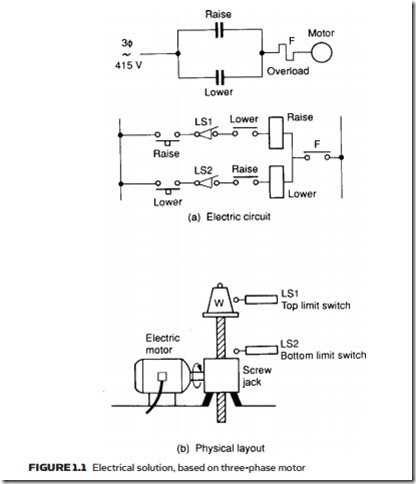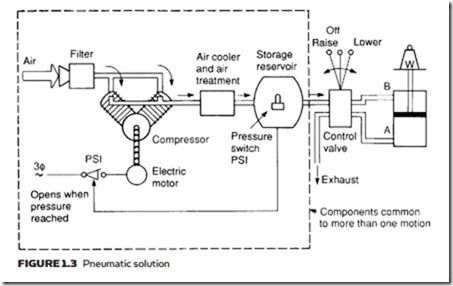a hydraulic system
A solution along hydraulic lines is shown in Figure 1.2. A hydraulic linear actuator suitable for this application is the ram, shown schematically in Figure 1.2a. This consists of a movable piston connected directly to the output shaft. If fluid is pumped into pipe A, the piston will move up and the shaft will extend; if fluid is pumped into pipe B, the shaft will retract. Obviously some method of retrieving fluid from the non-pressurized side of the piston must be incorporated.
The maximum force available from the cylinder depends on fluid pressure and cross-sectional area of the piston. This is discussed further in a later section but, as an example, a typical hydraulic pressure of 150 bar will lift 150 kg cm−2 of piston area. A load of 2000 kg could thus be lifted by a 4.2 cm diameter piston.
A suitable hydraulic system is shown in Figure 1.2b. The system requires a liquid fluid to operate; this is expensive and messy and, consequently, the piping must act as a closed loop, with fluid transferred from a storage tank to one side of the piston, and returned from the other side of the piston to the tank. Fluid is drawn from the tank by a pump which produces fluid flow at the required 150 bar.
Such high-pressure pumps, however, cannot operate into a dead-end load as they deliver constant volumes of fluid from input to output ports for each revolution of the pump shaft. With a dead-end load, fluid pressure rises indefinitely, until a pipe or the pump itself fails. Some form of pressure regulation, as shown, is therefore required to spill excess fluid back to the tank.
Cylinder movement is controlled by a three-position changeover valve. To extend the cylinder, port A is connected to the pressure line and port B to the tank. To reverse the motion, port B is connected to the pressure line and port A to the tank. In its center position the valve locks the fluid into the cylinder (thereby holding it in position) and dead-ends the fluid lines (causing all the pump output fluid to return to the tank via the pressure regulator).
There are a few auxiliary points worthy of comment. First, speed control is easily achieved by regulating the volume flow rate to the cylinder (discussed in a later section). Precise control at low speeds is one of the main advantages of hydraulic systems.
Second, travel limits are determined by the cylinder stroke and cylinders, generally, can be allowed to stall at the ends of travel so no overtravel protection is required.
Third, the pump needs to be turned by an external power source, almost certainly an AC induction motor which, in turn, requires a motor starter and overload protection.
Fourth, hydraulic fluid needs to be very clean, hence a filter is needed (shown in Figure 1.2b) to remove dirt particles before the fluid passes from the tank to the pump.
A Brief System Comparison
One final point worth mentioning is that leaks of fluid from the system are unsightly, slippery (hence hazardous) and environmentally very undesirable. A major failure can be catastrophic.
At first sight Figure 1.2b appears inordinately complicated compared with the electrical system of Figure 1.1, but it should be remembered that all parts enclosed in the broken-lined box in Figure 1.2 are common to an area of plant and not usually devoted to just one motion as we have drawn.
a pneumatic system
Figure 1.3 shows the components of a pneumatic system. The basic actuator is again a cylinder, with maximum force on the shaft being determined by air pres- sure and piston cross-sectional area. Operating pressures in pneumatic systems are generally much lower than those in a hydraulic system, 10 bar being typical, which will lift 10 kg cm−2 of piston area, so a 16 cm diameter piston is required to lift the 2000 kg load specified in the previous section. Pneumatic systems therefore require larger actuators than hydraulic systems for the same load.
The valve delivering air to the cylinder operates in a similar way to its hy- draulic equivalent. One notable difference arises out of the simple fact that air is free; return air is simply vented to the atmosphere.
Air is drawn from the atmosphere via an air filter and raised to required pres- sure by an air compressor (usually driven by an AC motor). The air temperature is raised considerably by this compressor. Air also contains a significant amount of water vapor. Before the air can be used it must be cooled, and this results in the formation of condensation. So, the air compressor must be followed by a cooler and air treatment unit.
Compressibility of a gas makes it necessary to store a volume of pressurized gas in a reservoir, to be drawn on by the load. Without this reservoir, a slow
exponential rise in pressure results in a similar slow cylinder movement when the valve is first opened. The air treatment unit is thus followed by an air reservoir.
Hydraulic systems require a pressure regulator to spill excess fluid back to the tank, but pressure control in a hydraulic system is much simpler. A pressure switch, fitted to the air reservoir, starts the compressor motor when pressure falls and stops it again when pressure reaches the required level.
The general impression is again one of complexity, but units in the broken-lined box are again common to one plant or even a whole site. Many factories produce compressed air at one central station and distribute an air ring main to all places on the site in a similar way to other services such as electricity, water or gas.
a comparison
Table 1.1 gives superficial comparisons of the various systems discussed in the previous sections.


